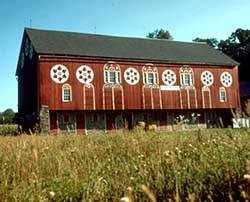Key Takeaways
- Historically, "barn red" is not the bright red seen today but a burnt-orange red, originating from European farmers who sealed barn wood with a linseed oil mixture, sometimes adding blood from slaughters or ferrous oxide (rust) for color and protective qualities.
- European settlers brought the tradition of red barns to the United States. By the mid to late 1800s in the U.S., red paint became the cheapest option due to the affordability of chemical pigments.
- Over time, as whitewash became cheaper, white barns started to appear, but the tradition of red barns persists.
If you've ever driven through a rural area, it's likely that you've seen the red barns that speckle the farming landscape. There are several theories as to why barns are painted red.
Centuries ago, European farmers would seal the wood on their barns with an oil, often linseed oil -- a tawny-colored oil derived from the seed of the flax plant. They would paint their barns with a linseed-oil mixture, often consisting of additions such as milk and lime. The combination produced a long-lasting paint that dried and hardened quickly. (Today, linseed oil is sold in most home-improvement stores as a wood sealant). Now, where does the red come from?
Advertisement
In historically accurate terms, "barn red" is not the bright, fire-engine red that we often see today, but more of a burnt-orange red. As to how the oil mixture became traditionally red, there are two predominant theories:
- Wealthy farmers added blood from a recent slaughter to the oil mixture. As the paint dried, it turned from a bright red to a darker, burnt red.
- Farmers added ferrous oxide, otherwise known as rust, to the oil mixture. Rust was plentiful on farms and is a poison to many fungi, including mold and moss, which were known to grown on barns. These fungi would trap moisture in the wood, increasing decay.
Regardless of how the farmer tinted his paint, having a red barn became a fashionable thing. They were a sharp contrast to the traditional white farmhouse.
As European settlers crossed over to America, they brought with them the tradition of red barns. In the mid to late 1800s, as paints began to be produced with chemical pigments, red paint was the most inexpensive to buy. Red was the color of favor until whitewash became cheaper, at which point white barns began to spring up.
Today, the color of barns can vary, often depending on how the barns are used.
For more information on barns, farms and related topics, check out the links on the next page.
Advertisement
